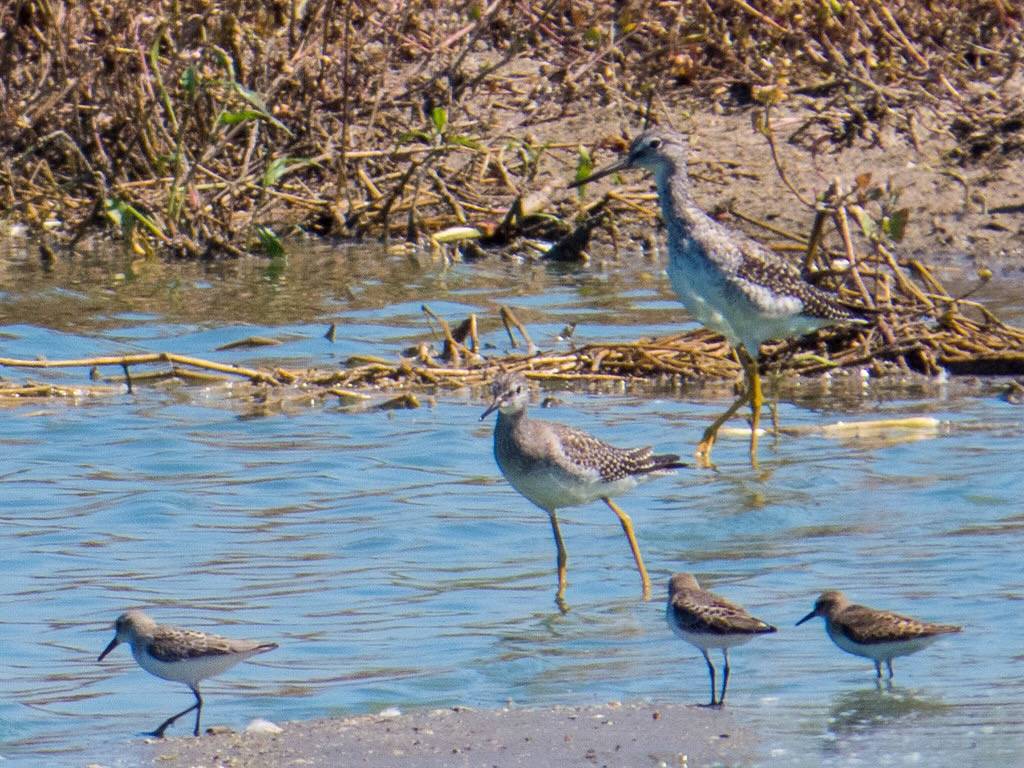Lesser Yellowlegs
The Lesser Yellowlegs is a medium-sized shorebird that has visited Salter Grove in April, August and September. Its very long bright yellow legs are conspicuous as it walks on exposed mud flats or wades in shallow water probing for aquatic invertebrates. Good vantage points would be at the boat launch or along the causeway during low tide.
It has a plumage that is nearly identical to that of the Greater Yellowlegs. The two are easily confused unless they are standing side by side. Unfortunately they are rarely seen together even though both species migrate through the park at about the same time of year. Despite their close resemblance, however, taxonomists do not consider them to be close relatives.
With practice, solitary individuals of the two species can be identified. The Lesser Yellowlegs usually has an all black bill that appears thin and needle-like and at about the same length as the width of the head in profile. By comparison, the Greater Yellowlegs has a slightly upturned bill that may be grayish at the base and is 1.5 times longer than the width of the head. The Lesser Yellowlegs is half the size of the Greater Yellowlegs and appears more dainty.
The migration pattern of Lesser Yellowlegs has been revealed with the use of automated radio telemetry. Nano transmitters are attached to birds when they are banded by researchers. The individually unique signals emitted are picked up when tagged birds fly within kilometers of a Motus tower. The data collected then becomes accessible to researchers in real time through the internet.
Hard to believe, but the signal from a tagged Lesser Yellowlegs was detected in South Dakota by Motus on 22 July 2022 and then again the following day in coastal North Carolina 1,500 miles away! Previous reports indicated that migratory birds, depending on the species, fly from 15 to 625 miles a day.
Wintering Lesser Yellowlegs tagged in Colombia have been documented by Motus to travel northward to their boreal breeding grounds and then back again. However, despite the network of over 900 Motus towers, it has not been possible to pin down exact breeding sites. Most of the towers are in North America but they are very sparse in the boreal region.
Due to its popularity as a tasty game bird, the Lesser Yellowlegs declined in numbers until it was protected from hunters in North America by the Migratory Bird Treaty Act early in the 20th century. Populations rebounded by mid-century but are now declining again in the 21st century because of wetland habitat loss within its wintering range. A clear picture of its migration routes will be crucial in directing conservation efforts.
For more information:
https://www.allaboutbirds.org/guide/Lesser_Yellowlegs
https://www.audubon.org/field-guide/bird/lesser-yellowlegs
https://www.borealbirds.org/bird/lesser-yellowlegs
https://mirrormagic.com/2022/04/05/greater-or-lesser-yellowlegs/
https://www.birdzilla.com/bird-identification/id-skill-development/comparisons-of-similar-bird-species/comparison-of-lesser-and-greater-yellowlegs.html
https://www.audubon.org/news/yellowlegs-mysteries-revealed
https://motus.org/
















